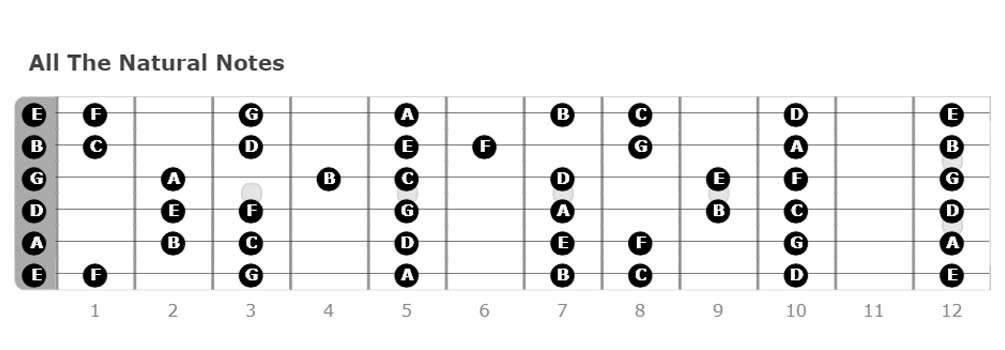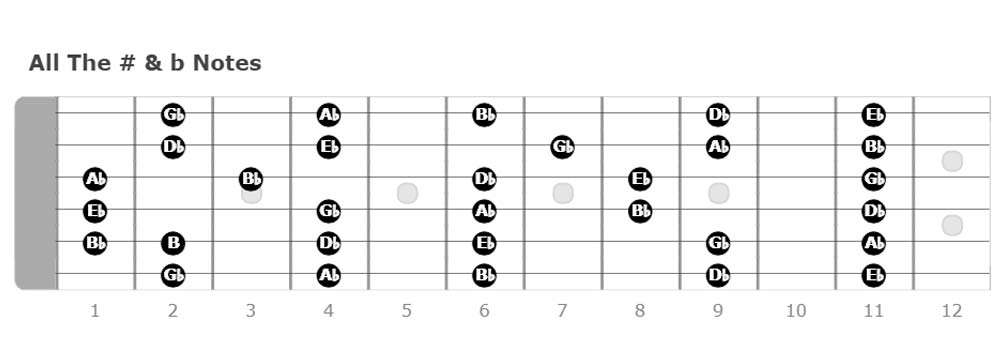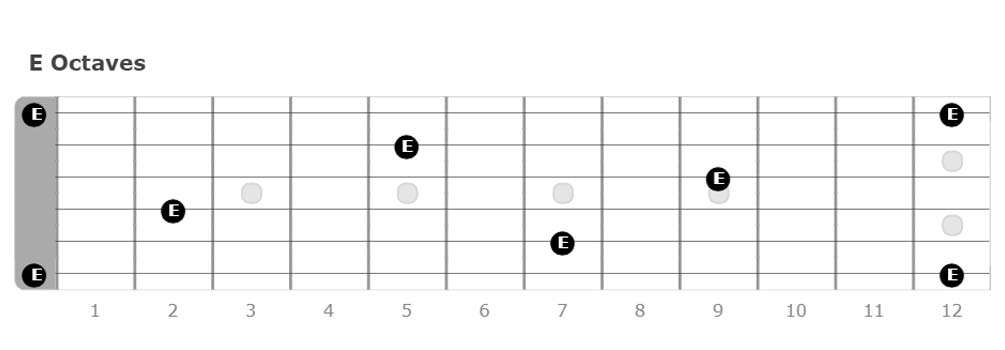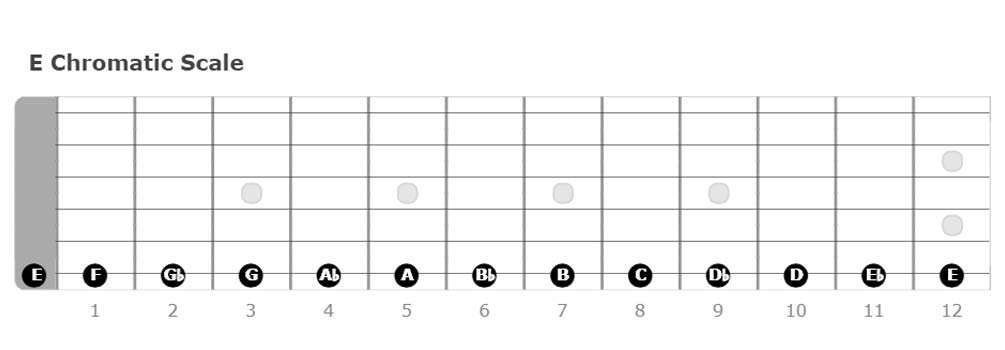Playing the guitar is a rewarding and creative musical experience, but understanding and memorizing the various guitar notes on the fretboard can be difficult for beginners.
The musical alphabet is where it all beings, which consists of seven letters (A-G) & serves as the basis for all music notation.
In between these 7 notes, we also have flat & sharp notes for a total of 12 possible notes. Each note representing a half step or “semitone”. All 12 of these half steps form what is known as an octave, which are two notes with similar tone but 12 semitones apart.
Because the musical alphabet is repeated across the guitar neck, you will notice a pattern of the same note on different strings and frets as you progress in your guitar playing journey.
Understanding the relationships between guitar notes and their fretboard positions is essential for effective memorization. This article, we’ll get you up to speed on learning all of the concepts behind guitar notes, as well as how to break down the guitar neck into manageable sections for a big jump towards fretboard mastery.

Intro To The Musical Alphabet
The musical alphabet, consisting of seven letters – A, B, C, D, E, F, and G – forms the foundation of all music notation. Each letter represents a distinct pitch or sound that can be played on any guitar string.
The guitar fretboard is composed of six strings, starting with the thickest string (also known as the bottom string) and ending with the thinnest string – Both of which have the pitch of “E” when the guitar is tuned to E Standard.
When referring to specific notes on the guitar strings, it’s important to keep in mind that each open string also corresponds to a particular note:
E (the sixth string), A (the fifth string), D (the fourth string), G (the third string), B (the second string), and E again (the first or thinnest string).
Understanding how notes are arranged on a single guitar string allows for an easy starting point & helps with recognizing patterns throughout all six strings.
In the sections below we will break down the musical alphabet further from 7 natural notes, to 12 total possible notes including “sharps or flats”. Then, how these 12 notes form an octave and how these octaves repeat themselves throughout the guitar fretboard.
What Are Natural Notes?
Natural notes are the foundational building blocks of musical expression, forming the core framework upon which concepts like basic guitar chords and guitar scales are constructed. As previously mentioned, these notes consist of the seven letters of the musical alphabet: A, B, C, D, E, F, and G
They represent the fundamental pitches in Western music and serve as reference points for both melody and harmony.
On the guitar, natural notes are easily identified on the fretboard. Each open string produces a natural note, and these notes repeat in a specific pattern as you move up the fretboard.

What Are Sharp and Flat Notes?
Sharps or flats are important musical elements that change the pitch of natural notes in the musical alphabet. The musical alphabet is made up of seven basic notes: A, B, C, D, E, F, and G which are all a whole step apart. Sharps (#) and flats (b) are used when we need to change the pitch of a note by a half step, either up (sharpening) or down (flattening).
Sharps (#)
A sharp note raises the pitch of a natural note by one half step. For instance, if you take the note C and add a sharp, you get C#. This note sits right between the natural notes C and D, effectively increasing the pitch by a half step.
Flats (b)
Similarly, a flat note lowers the pitch of a natural note by one half step. If we take the note D and apply a flat, we arrive at Db, which falls between the natural notes C and D but on the lower pitch side.
| Natural Note | Sharp (#) | Flat (b) |
|---|---|---|
| A | A#/Bb | G#/Ab |
| B | – | A#/Bb |
| C | C#/Db | B |
| D | D#/Eb | C#/Db |
| E | F | D#/Eb |
| F | F#/Gb | E |
| G | G#/Ab | F#/Gb |
The relationship between sharps and flats is known as enharmonic equivalence. This means that certain notes can be spelled in different ways while representing the same pitch.
For instance, C# and Db are enharmonically equivalent; they refer to the same note on the guitar but might be notated differently depending on the context of the music.
Sharps and flats enrich the musical language, by injecting 5 more possible notes in additional to the 7 natural notes for a total of 12 possible notes to choose from.
These notes include A, A#/Bb, B, C, C#/Db, D, D#/Eb, E, F, F#/Gb, G, and G#/Ab
Below are all the sharp or flat notes on the fretboard when using standard tuning.

What Are Octaves?
Octaves are a fundamental concept in music theory, representing a specific interval between two notes that share the same tonal quality but differ in pitch.
More precisely, an octave encompasses twelve half steps, effectively spanning the entirety of the musical alphabet from one note to its higher or lower counterpart. This interval holds immense significance in music as it symbolizes harmony and balance, allowing for a seamless progression from one tonal level to another.
To illustrate this concept, let’s consider the note “E” and its octaves on various guitar strings. Beginning with the low E string, the open string itself produces an “E.” As you move to the A string and press down on the 7th fret, you achieve the next “E” note, constituting the first octave. Similarly, shifting to the D string and playing at the 2nd fret yields yet another “E,” completing another octave. This pattern persists on the G string (9th fret), B string (5th fret), and high E string (5th fret), where each corresponding fret produces an “E,” forming successive octaves.

What Is The Chromatic Scale?
The chromatic scale is a musical scale that includes all twelve pitches within an octave, moving sequentially in half steps, also known as semitones.
In other words, the chromatic scale spans all the available notes in Western music, encompassing both the natural notes (A, B, C, D, E, F, G) and the intervening sharps and flats. This scale provides a comprehensive framework for understanding the relationships between all possible pitches and serves as a crucial tool for composing, improvising, and understanding music theory.

Guitar Notes & Memorization Techniques
One of the easiest and widely used memorization techniques for remembering all the guitar notes involves using mnemonics based on acronyms or phrases.
One such popular method is the “Every Good Boy Does Fine” acronym, which helps you remember the names of the notes on the lines of the treble clef in standard notation: E, G, B, D, F.
Similarly, for the spaces between the lines, you can use the phrase “FACE” to remember the notes F, A, C, and E.
For the guitar’s open strings, “Eddie Ate Dynamite, Good-Bye Eddie” is a mnemonic that corresponds to the standard tuning of the six strings: E, A, D, G, B, E. This technique provides a simple and memorable way to recall the names of the open strings in their correct order.
These mnemonics, combined with consistent practice and repetition, can significantly aid in memorizing the guitar notes and developing familiarity with the guitar fretboard. However, it’s essential to complement these techniques with hands-on practice to truly internalize and apply the knowledge effectively.
Learning the Fretboard in Sections
To learn the guitar fretboard, break it down into manageable sections by dividing the fretboard into two or three adjacent strings or a particular region of the neck. This helps you focus on a limited number of notes at a time, making it less overwhelming.
For example, start by familiarizing yourself with the open strings – E and A for the thickest string and its neighboring string, D.
Next, identify notes along these strings using half steps (one fret) and whole steps (two frets). For example, starting from E on the thickest string’s open position, moving up one half step leads to F note at the first fret. Similarly, going up another half step brings us to F# at the second fret.
Continually learn all 12 notes within this small section using half and whole steps along both strings while paying attention to enharmonic notes.
Utilizing visual aids like fret markers can enhance your learning experience further. These markers are typically found on certain positions along the guitar neck and serve as visual cues for locating specific notes quickly.
By incorporating these markers into your practice routine, you will develop a more intuitive sense of note placement. As you become comfortable with one section of the guitar’s neck and its corresponding notes in relation to each other within that region, gradually expand your knowledge to include more strings or different areas of the fretboard.
Consistency and regular practice are vital in reinforcing your understanding of guitar notes and their positions. This systematic learning approach will empower you to confidently navigate the fretboard, enabling you to play chords, melodies, and solos with ease.
Summarizing Notes on A Guitar
Now that you have learned about the musical alphabet (natural notes, plus sharps and flats), the chromatic scale, octaves, it’s time to put all of this knowledge into practice and review everything comprehensively.
To begin, let’s recall the string names on the guitar. Starting from the thickest string to the thinnest string, they are E-A-D-G-B-E.
Remembering these string names is vital as it provides us with a foundation for understanding and locating different notes on the fretboard. Next, let’s review some note relationships.
For instance, if we play an open E string, we can play the same pitch on a higher octave by pressing down at the twelfth fret of that same string, both will produce an E note. That’s because the guitar fretboard notes reset at the 12th fret.
In addition to single notes, understanding how chords relate to our knowledge of guitar notes is crucial. By combining different strings and frets together in specific patterns, we can learn basic guitar chords that will take our guitar music abilities to the next level.
Frequently Asked Questions
What are the 6 notes on a guitar?
If you mean the 6 note for the open strings, they are EADGBE
What are all 12 notes on guitar in order?
The twelve notes on a guitar, in ascending order, are: E, F, F#/Gb, G, G#/Ab, A, A#/Bb, B, C, C#/Db, D, and D#/Eb.
These notes encompass the chromatic scale, spanning an entire octave and forming the foundation for music theory.
What are the easy notes for guitar?
On the guitar, “easy” notes can refer to open strings, which are the notes produced when you play the strings without pressing any frets down.
The open string notes in standard tuning are E, A, D, G, B, and E, from the thickest string to the thinnest string. These open string notes are frequently used as the starting point for learning basic chords, scales, and melodies on the guitar, making them essential for beginners.
What is the highest note on a guitar?
The highest note on a guitar depends on the number of frets it has. If it has 22 frets, the highest note is D & if it has 24 frets, the highest note is E.
How many notes are on a guitar?
On a guitar with 22 frets, there are 138 notes and on a guitar with 24 frets, there are 150 notes. These include the open notes on each string.
